(A version of this article was originally published in The Horn, autumn 2013. Author: Susie Ellis, PhD, Executive Director, International Rhino Foundation)
In 1996, the Sumatran rhino was listed as Critically Endangered on the IUCN Red List of Threatened Species. Since then, more than 75% of the population has been lost. Surveys in 2012 in Malaysia suggest that no more than a handful of rhino may remain in Sabah. This alarming news prompted discussions concerning the need for rapid, international and collaborative action, and most importantly, a departure from the ‘business as usual’ approach if the species is to have any hope of survival. A recent review of population data now suggests that it is quite possible that only around 100 Sumatran rhino now remain in the wild. Ten individuals are in managed breeding facilities in Indonesia, Malaysia, and the US.
From 1-4 April 2013, united in a fear of losing the Sumatran rhino, yet with hope that a new, creative, and effective strategy could be developed and implemented in time to save it, 109 participants from various organizations and institutions working on Sumatran rhino and other endangered species gathered for the Sumatran Rhino Crisis Summit (SRCS) at the Singapore Zoo. The SRCS was hosted by Wildlife Reserves Singapore and generously sponsored by the Sime Darby Foundation, the Wildlife Conservation Society, and the World Wide Fund for Nature.
In addition to Sumatran rhino experts, the meeting included biologists who have helped to recover other critically endangered species, such as the California condor, Hawaiian forest birds, saola, giant panda and African rhino species. It also included presentations by biologists who worked in cases that did not result in species recovery (e.g., the baiji, Vietnamese subspecies of Javan rhino). Moderated by a facilitator, panel members gave short introductions about the challenges they had faced and lessons learned that might be applicable for the Sumatran rhino.
During the rest of the meeting, participants self-managed 23 working sessions, in large and small breakout groups, documenting the most important outcomes from each one. At the end of each session, each group shared their discussions, including promising solutions and ideas to the entire assembly.
A Two-Year Emergency Plan was drafted to identify the most urgent actions, which will be followed by a five-year rolling strategic plan. The Emergency Plan acknowledges the need for:
- High-quality, standardised information on the sex, age, locations of individual wild rhinos, both through immediate surveys and continuing monitoring
- Management of all existing rhinos, whether wild or in managed breeding programmes, as one population by the governments of Indonesia and Malaysia, which are committed to preventing the species’ extinction
- Mechanisms to ensure decisive, high-energy conservation actions in range states with further mechanisms for collaboration between ranges states and other institutions
Other critical pieces of the Plan include aiming to manage the Sumatran rhino for an annual population growth rate of at least 3 percent. For Indonesia, which holds the only viable populations of Sumatran rhinos, general rhino conservation needs identified include:
- Establishing a high-level task force of senior Indonesian government decision makers supported by an advisory body of national and international experts on rhino population and habitat management, to make decisions on conservation management proposals in a timely manner and report each year to the President of Indonesia on the progress achieved in rhino conservation
- Appointing a full-time government focal point for rhino conservation within the Nature Conservation Division of the government of Indonesia
- Allocating sufficient resources, including adequate staff numbers, to the National Parks to enforce protection of remaining rhino populations in Bukit Barisan Selatan, Way Kambas and Gunung Leuser National Parks, and the wider Leuser Ecosystem (and in Ujung Kulon for Javan rhinos)
- Monitoring all rhino protection efforts using the SMART law enforcement monitoring database and sharing results with all stakeholders on a monthly basis
- Ensuring regular, frequent and intensive monitoring of all rhino populations in Indonesia, involving collaboration between all stakeholders, in order to detect population trends, and to inform future conservation and management decisions
- Exploring the possibility of co-management of Rhino Intensive Management Zones (IMZ) with the international community
Specific recommendations for Sumatran rhinos included:
- Establishing Intensive Management Zones (IMZ) in Bukit Barisan Selatan, Way Kambas and Gunung Leuser National Parks, and the larger Leuser Ecosystem; significantly increasing enforcement effort in these IMZs including considering fencing a portion of the IMZs to maintain rhino densities
- Moving rhinos that are outside of IMZs either into IMZs or into managed breeding facilities with a track record of success
- Forming a joint Sumatran Rhino Coordination Unit (SRCU) that involves the Governments of Indonesia, Malaysia and holders of Sumatran rhinos in other countries to oversee the transfer of animals and reproductive cells between the captive Sumatran rhino populations within individual countries and internationally
10. Permitting the movement of animals within and between IMZs and managed breeding facilities
In early October, the Indonesian government, in collaboration with the IUCN, will convene an Asian Rhino Range States meeting to call attention to the Asian rhino situation in India, Nepal, Bhutan, Indonesia and Malaysia. The meeting will take place just prior to the Asia-Pacific Economic Cooperation Business Advisory Council meeting in Bali, which will focus on security and wildlife enforcement. We are hopeful that the Asian Rhino Range States meeting and the APEC meeting discussions will lay a foundation for a rhino-related presidential decree by Indonesia’s President Susilo Bambang Yudhoyono.









